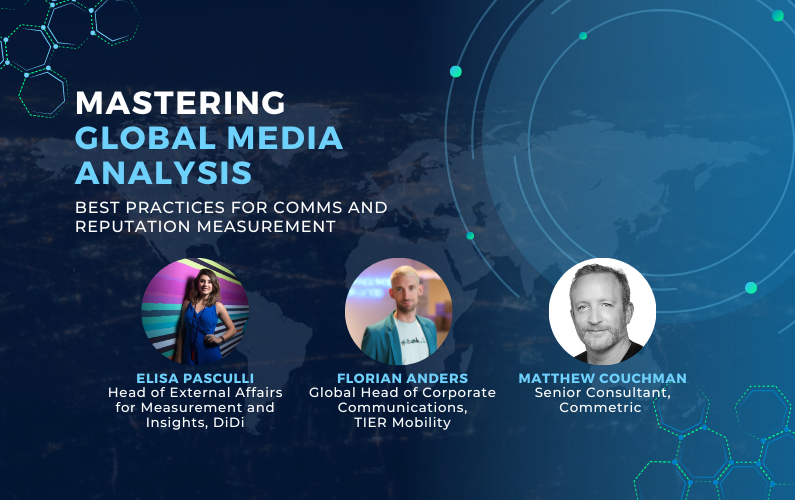In the current global business landscape, communications and PR professionals are increasingly relying on analytics to drive strategic decisions and showcase their value. In a dynamic and insightful Commetric webinar on “Mastering Global Media Analysis: Best Practices for Comms and Reputation Measurement”, Commetric’s Senior Consultant Matt Couchman conversed with communications experts Elisa Pasculli of DiDi and Florian Anders of TIER. Here are the key takeaways from their insightful conversation:
Comms Challenges and the Role of Media Analytics
Both Pasculli and Anders highlighted that having data-guided intelligence is necessary to inform comms strategies, manage crisis, and make informed decisions. They acknowledged that media analytics have been a valuable tool in their departments to guide their actions and justify their decisions.
Anders highlighted four key challenges he faced at TIER Mobility:
- Scarce Resources: Media analysis has aided in understanding how to allocate resources for maximum impact across all markets.
- Negative Media Sentiment: Shared micro-mobility being a controversial topic necessitates promoting the benefits of shared e-scooters to balance negative media sentiment.
- Planning Uncertainty: Media analysis helps in tackling planning uncertainties arising from external factors and rapidly changing internal timelines.
- Showcasing the Impact of Comms: Media analysis has also helped in demonstrating the impact of comms, leading to securing additional budget and resources.
KPIs in Comms Performance Measurement
When measuring the performance of comms, three key KPIs were highlighted by Florian Anders:
- Share of Voice: The goal is to be the loudest and most recognised player in a competitive market.
- Media Sentiment: An indicator of the proactiveness of comms in the market. The aim is not to have more than 10% negative articles.
- Spokesperson Visibility: This is an indicator of quality media coverage. The aim is for 10% of all articles to include a quote from a TIER spokesperson.
Elisa Pasculli added to this discussion by outlining the five pillars that they utilise:
- Presence (Share of Voice): How loud their company is.
- Tonality (Press Sentiment): The sentiment of the press towards the company.
- Media: The importance of the media coverage to the business strategy.
- Content: The focus is not only on the volume of stories, but also their context.
- Effort: The factors that drove the story, whether the company was proactive or reactive, and if the intended message landed in the story.
The Role of Reach Figures in Reporting
Both speakers emphasised the importance of quality over quantity when considering reach figures. Reach can be a useful metric for early-stage startups where the primary goal is to create brand awareness. However, as businesses mature, the focus should shift towards ensuring the right people are reading the articles. In such cases, the reach metric becomes less crucial than the quality of engagement and the nature of the target audience.
Consistency Is Key
Matt highlighted that consistent measurement, not absolute accuracy, is critical in tracking audience figures. A consistent methodology enables organisations to spot trends by noting the variations from one month to another. The focus isn’t on whether 32,000 or 45,000 people read a particular piece, but on the patterns that emerge over time.
The Importance of Adaptability Across Markets
Pasculli and Anders shared their strategies for handling analytics across diverse markets. Elisa stressed the importance of creating benchmarks that reflect each market’s reality. This includes establishing a standard definition for tier one media in each specific market and adapting it to their realities.
Benchmarking a country against itself, rather than other countries, emerged as a crucial practice. This takes into account the fact that different countries have different populations and media landscapes.
Florian backed up this perspective, emphasising the importance of a bottom-up strategy. In his experience, engaging closely with local agencies and defining the top tier media outlets – those with national wide audiences – is crucial. This approach ensures that their global strategy remains effective at a local level, considering the importance of regional and local newspapers.
The Role of Third-Party Data Providers
Bringing in third-party data providers can add value in terms of convenience and unbiased insights. According to Anders, these providers offer peace of mind, reliable data, and free up time and resources for teams to focus on proactive work, such as reaching out to the media. Elisa echoed these sentiments, particularly valuing the unbiased review offered by third-party data analysis.
Getting Stakeholder Buy-In for KPIs
Setting KPIs can be tricky, but both Elisa and Florian shared that being part of data-driven companies helped them get buy-in from stakeholders. Elisa pointed out that the challenge lies more in gaining buy-in from the entire comms team across different markets, as it is essential to ensure that everyone agrees on what will be reported.
Florian, on the other hand, found that setting up a clear reporting process that catered to the needs of his key stakeholders was met with appreciation.
Regularly Revisiting Your Analysis
Elisa and Florian both agreed on the need to regularly revisit and potentially re-scope the analysis. For Elisa, this is a quarterly process, aligning with their reporting structure. It’s a chance to ensure they’re monitoring the most important features and adapting to an ever-changing industry.
In Florian’s case, while the initial setup requires the most effort, it is crucial to make small amendments on a regular basis to ensure the right outlets and competitors are being monitored.
These insights provide a clear roadmap for organisations looking to refine their media analysis strategies. They demonstrate how media analytics can support the communications department in making informed decisions, managing crisis, promoting positive sentiment, and showcasing the impact of their work. Consistency, adaptability, strategic use of third-party data, clear KPIs, and regular check-ins are all essential components of successful global media analysis.

